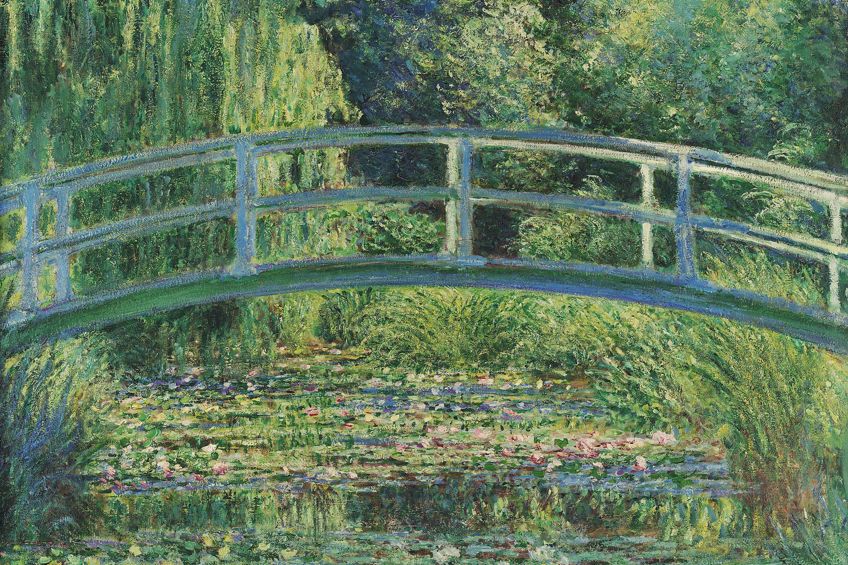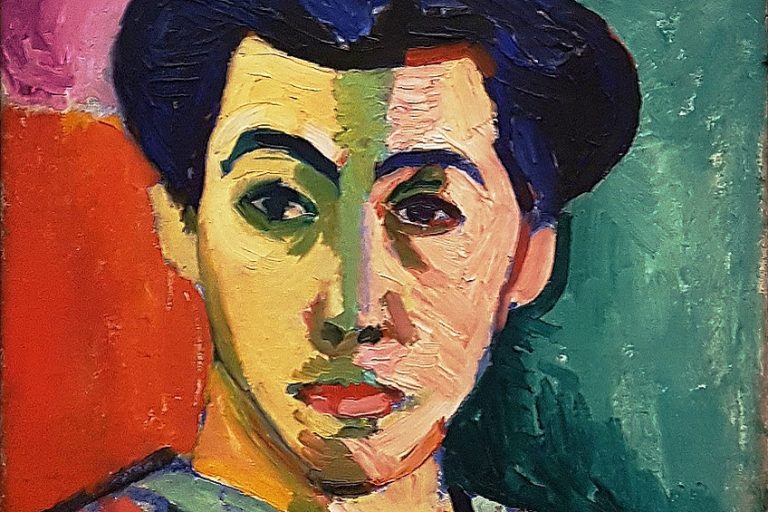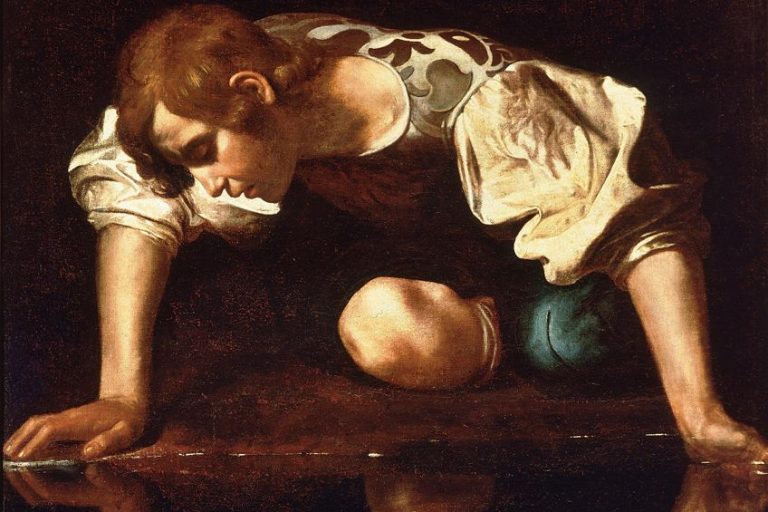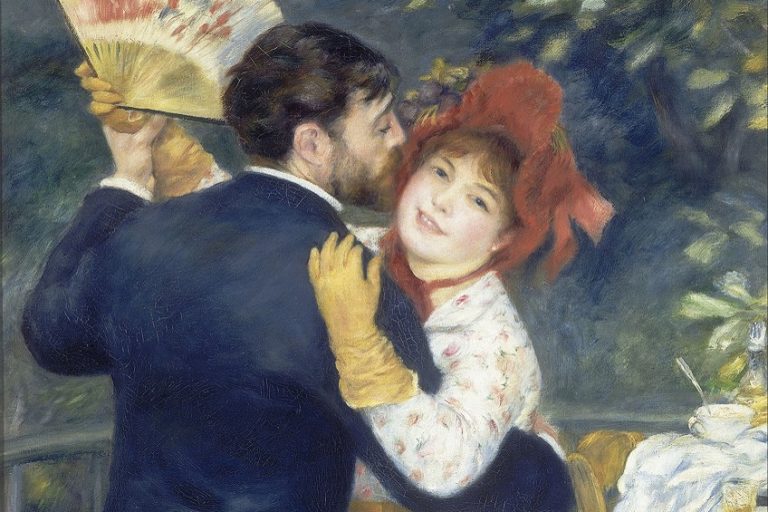Impressionist Paintings – A Look at the Best Impressionism Artworks
The Impressionism movement took off during the 19th century in Paris when a group of independent artists decided to host their own exhibition for their paintings that were routinely excluded from The Salon. Reaching a peak during the 1870s and 1880s, Impressionism broke all of the conventional rules associated with traditional academic painting, as it encouraged artists to capture ordinary scenes and paint outdoors. The influence of this period eventually led to the emergence of Neo-Impressionism, Post-Impressionism, Fauvism, and Cubism.
What Did the Impressionism Movement Stand For?
Initiated by a group of artists in 19th century Europe, Impressionism was an art movement that violated all of the rules associated with traditional art. Growing tired of the archaic exhibitions and salons, whereby only government-approved artworks were allowed to be on display, this group of free thinkers established Impressionism as a new avant-garde movement.
Impressionist artists began to choose landscapes, common activities, and objects as their prime subject matters, which differed greatly from the customary art of the time.
This came as quite a change, as Europe had only witnessed grand subjects in art at that time, such as the depiction of major historical events that took place. Ordinary life and outdoor scenes quickly became the prime subjects of artists during the Impressionist period, as they were encouraged to experiment with a new technique called en plein air. This technique required artists to physically sit outside in nature and paint exactly what they saw, which allowed them to accurately capture the fleeting nature of sunlight and atmosphere.
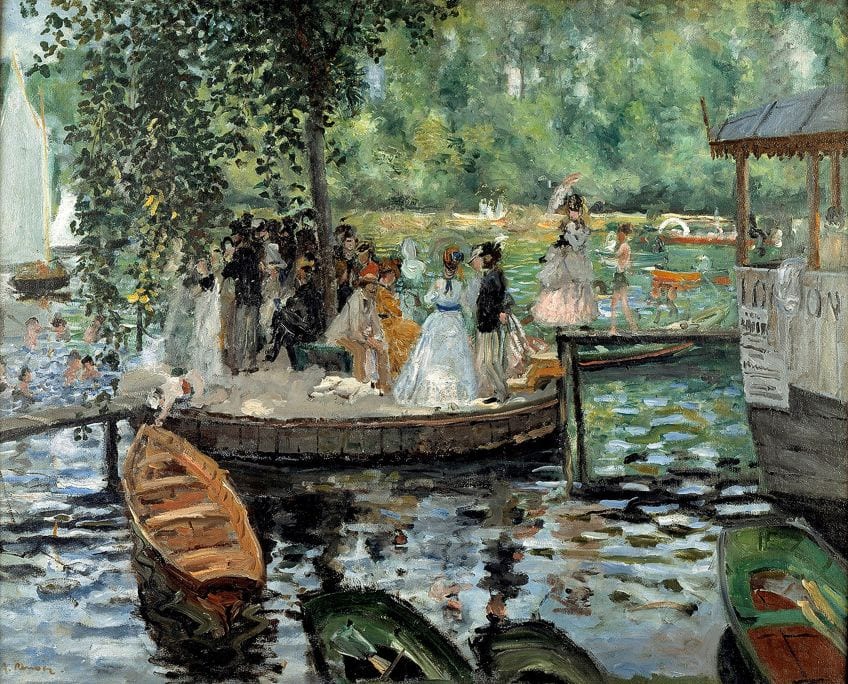
Due to this new approach, Impressionist paintings were characterized by small yet discernible brushstrokes that placed great emphasis on capturing the ever-changing quality of light and ordinary subject matter. A more open type of composition was created, which expressed the richer sense of movement that artists found when painting en plein air. Scenes of modern life often went unplanned, which added a more realistic element to the paintings and directly apposed the more academic paintings that were previously done in studios.
Impressionism as a style allowed freely and lightly brushed colors to take priority over lines and contours, as artists favored loose representations over concrete details.
Brushstrokes and colors in Impressionist paintings became clearer so as to accurately convey the ordinary subject matter that was being looked at. Additionally, the various layering of paint went on to help emphasize the precise depiction of light in its varying qualities and unconventional visual angles.
Apart from having unique brushstrokes and common subject matter, other important characteristics of Impressionism included the use of vibrant colors, honest poses and compositions, and a focus on the accurate depiction of temporary light. Thus, the paintings produced during this period were incredibly subjective, as they were based on how the artist perceived their surroundings.

In essence, the Impressional art movement stood to merely create an “impression” of an outdoor scene that placed focus on how light interacted with the surrounding world, with the paintings being characterized by looser and lighter brushwork. Initially facing a lot of criticism when it first started, the Impressionism movement began to slowly gather a following, which eventually led to Impressionist offshoots in both media and literature.
Seen as a significant step forward in the world of French painting, Impressionism is considered to be one of the most important art movements to ever exist as it was seen as the first true emergence of modern art. Artists abandoned historical scenes and royal portraits in favor of painting simply what they saw in the world around them, which made for more authentic art.
Our Top 15 Most Famous Impressionist Paintings of All Time
When investigating the Impressionism period, many paintings stand out due to the new and experimental techniques that artists were using at the time. However, specific Impressionism artworks captured the essence of the movement better than others and are therefore considered to be the most notable Impressionist paintings to exist. While our list below is certainly not exhaustive, it covers 15 of the most famous Impressionist paintings from the entire movement.
The Luncheon on the Grass (Le Déjeuner sur l’herbe) – Édouard Manet (1863)
| Artist | Édouard Manet (1832 – 1883) |
| Date Painted | 1863 |
| Medium | Oil on canvas |
| Dimensions | 208 cm x 264.5 cm (81.9 in x 104.1 in) |
| Where It Is Currently Housed | Musée d’Orsay, Paris |
Painted by French artist Édouard Manet in 1863, The Luncheon on the Grass (Le Déjeuner sur l’herbe) exists as one of his most significant paintings of all time, in addition to being considered an important Impression artwork. Manet’s painting depicts a scantily clad female bather who appears to be having a picnic with two fully dressed men somewhere out in a forest.
Despite this artwork sparking public outrage due to the nudity shown, the atmosphere felt when viewing this work is incredibly calm and untroubled.
Considered to be the most controversial painting of the 19th century, Manet submitted The Luncheon on the Grass to be exhibited at the annual Salon des Beaux-Art, but the painting was rejected by the jury. This was because an image of an undressed woman shown to casually be in the company of two fully dressed men was considered to be an insult to the accepted behavior and morals of the time.
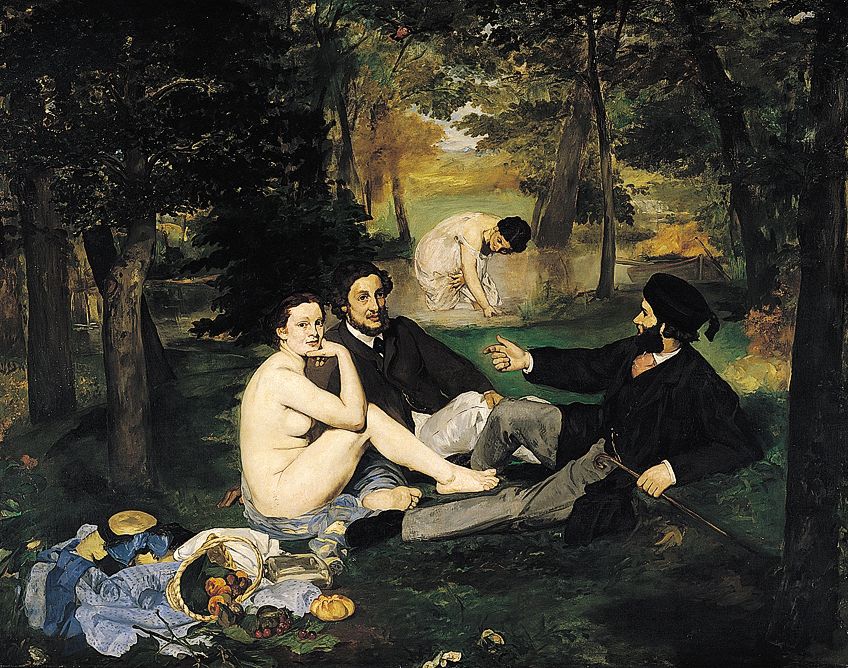
After being denied entrance to the show, Manet decided to exhibit his painting at the Salon des Refuses, known as the “exhibition of the refused”, which shocked the bourgeois French society greatly. The Impressionist painting went on to be visited by countless people attending the Salon, however, this was done to purely mock and jeer at the work, as society completely dismissed the potential that was evident in Manet’s painting.
Despite receiving a hostile reaction from the public, Manet’s Impressional art piece bewildered both viewers and critics alike. Influenced by the Renaissance period, Manet constructed his female nude into the central point within this painting, yet it is the way that she remains completely unidealized despite her lack of clothing that perplexed audiences the most.
Her gaze, which stares directly out of the painting, confronts viewers in an almost sensual way, which invites them to keep admiring the painting. Upon closer inspection, the second bathing figure in the background makes herself known, which raises the question as to why the female in the foreground appears to be the most striking. Perhaps it is through her nonchalance that directly invites viewers into the composition but the more one considers this painting, the more one wonders why Manet depicted the men as fully clothed.

Through extracting the female nude from the justified contexts of mythology and orientalism, and in allowing his female subject to confidently challenge viewers through her gaze, Manet was able to shock upper-class society through the brazenness in this painting. Through his sharper outlines and exaggerated color contrasts, Manet introduced a type of painting that society had never encountered before, as he disregarded all traditional techniques in an effort to depict an incredibly indecent yet contemporary scene.
While some critics branded this Impressionist painting as nothing more than a “young man’s practical joke”, Manet’s work thus launched the introduction of the avant-garde into art. His painting challenged the conventions of the time and ultimately earned him the fame and patronage that he sought.
While this painting is often considered to be the origin of Impressionism, it would take French society another two or three decades before it was fully appreciated and understood.
Olympia – Édouard Manet (1863)
| Artist | Édouard Manet (1832 – 1883) |
| Date Painted | 1863 |
| Medium | Oil on canvas |
| Dimensions | 130.5 cm x 190 cm (51.4 in x 74.8 in) |
| Where It Is Currently Housed | Musée d’Orsay, Paris |
Another of Édouard Manet’s influential Impressionist paintings is his artwork titled Olympia , which was painted in 1863 as well. However, after the backlash that he received from exhibiting The Luncheon on the Grass (1863) at the Salon des Refuses, Manet knew that his new painting would be equally as controversial. To avoid any more contestation, he went on to hide his painting in his studio for about 18 months before deciding to exhibit it at the 1865 Salon.
Within Olympia, Manet depicts a naked woman lying on a bed while a woman of color, presumed to be her servant, brings flowers to her. Based on the title of the painting, the woman is assumed to be a prostitute, as the name “Olympia” was commonly affiliated with the sex industry at the time, with the flowers thought to be a gift sent to her by a satisfied customer. Despite her stark nudity, the figure’s hand attempts to cover herself in a modest way whilst giving off a deliberately sensual and gratified feeling.
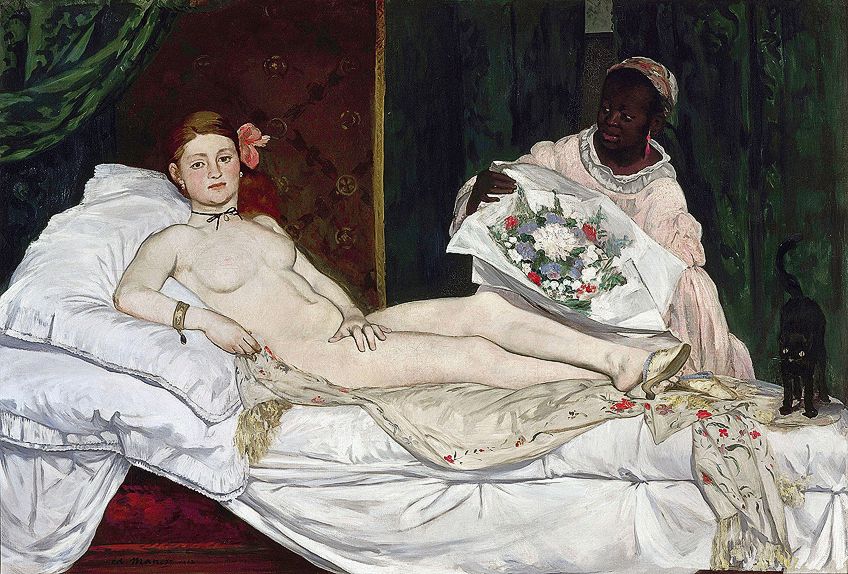
The atmosphere felt within this painting is filled with sensuous references, as the pearl earrings, black ribbon, and orchids that the figure wears were said to be very provocative objects at the time. Additionally, the inclusion of the black cat in the composition, with its tail raised, was said to be another acknowledgment of the sex industry during the time of this Impressionist art piece.
Through representing a lower-class prostitute, Manet’s painting was intended to shock the bourgeois audience with the hidden, yet still very well-known reality of prostitution in France.
Characterized by its broad brushstrokes, many criticized Manet’s work for being unskilled and childish due to its ridiculous subject matter. Through the confrontational gaze that Manet painted the figure with, she is given both a face and identity, which went on to humanize the profession of prostitution despite society seeing it as something vulgar.
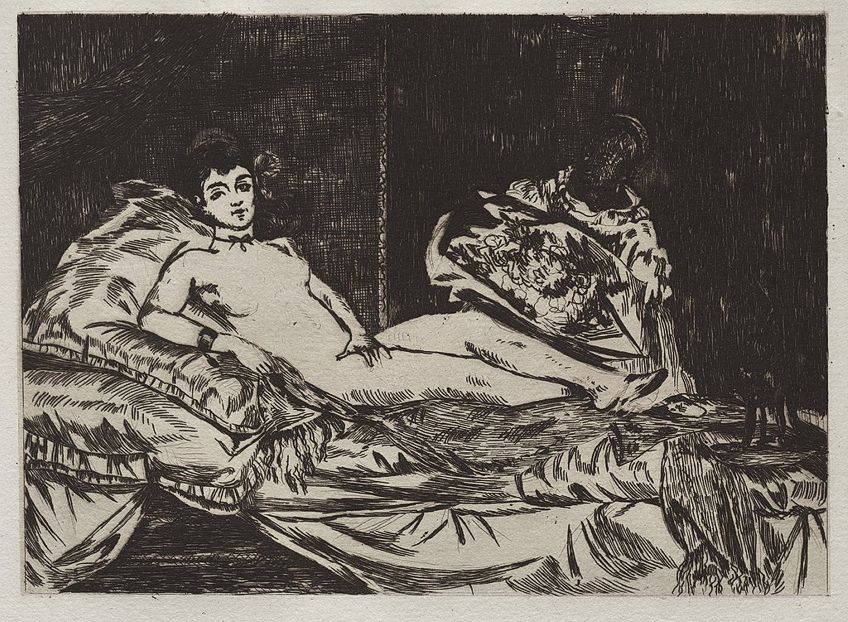
Seen as a provocative work of art, Olympia was rife with hypocrisy, as prostitution was exceedingly popular during the 19th century despite the upper-class society choosing to pretend that it did not exist. With the figure causing quite an uproar through her unapologetic and brazen stare, many critics stated that Manet’s sole motivation behind such an indecent painting was to attract attention at any price.
Despite the protestations that Olympia was met with, the painting was surprisingly accepted by the Salon’s jury to be exhibited in 1865. However, more criticism followed this, which eventually led to Manet traveling to Spain for a while to escape the commotion he had caused.
Through the heightened sexuality present, this painting of a woman clearly unashamed with her body is considered to be one of the most controversial paintings to come from the Impressionist movement.
Bazille’s Studio (L’atelier de Bazille) – Frédéric Bazille (1870)
| Artist | Frédéric Bazille (1841 – 1870) |
| Date Painted | 1870 |
| Medium | Oil on canvas |
| Dimensions | 48 cm x 65 cm (19 in x 26 in) |
| Where It Is Currently Housed | Musée d’Orsay, Paris |
French artist Frédéric Bazille is considered to be a notable Impressionism artist due to the types of paintings he produced during the art movement. His 1870 painting, titled Bazille’s Studio (L’atelier de Bazille) is remembered as one of his most famous works from the period. As he, unfortunately, died young, Bazille did not go on to produce many artworks, which is why Bazille’s Studio is considered to be his masterpiece.
Within the artwork, Bazille depicted many iconic Impressionist figures walking around his studio, which included Claude Monet, Édouard Manet, Pierre-Auguste Renoir, Emile Zola, and Edmond Maître. While Bazille painted similar scenes from three of his other art studios, this Impression artwork is considered to be the best of the trio despite appearing more Realistic than Impressionistic in terms of technique. What makes this painting so unique is that Bazille included a portrait of himself, which was painted by Manet, within the work.
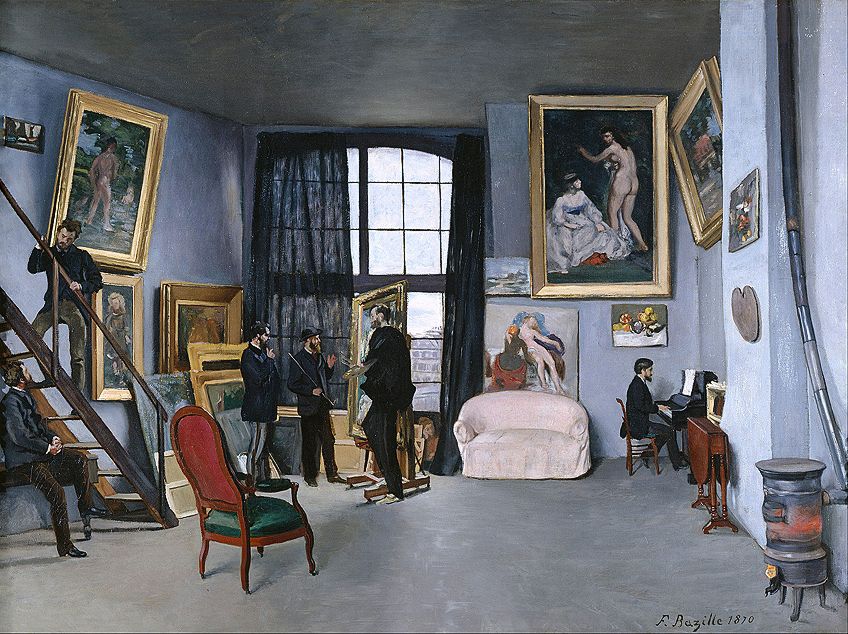
Bazille himself also becomes the main focal point within this painting, as he depicts himself as the central figure leaning towards the easel. He is shown to be holding a painter’s palette in his hand, which identified him as the owner of the artist studio, whilst talking to a figure suspected to be Manet about the painting in progress. As time has gone on, much contention has appeared as to the correct identification of the other figures in Bazille’s painting, as they were said to depict his artistic friends. However, we will never know their true identities.
Above the figure of Bazille, a still-life painting by Monet is depicted. This was said to represent the financial assistance that Bazille offered to his contemporaries, as he came from a wealthy family and was able to offer support when exhibitions turned their paintings down. The other paintings on the wall are made up of works that were also rejected by the Salon in 1870, with their inclusion here said to be a barely hidden critique of the academy, who they found to be incredibly inconsistent.
This Impressionist art piece represents the distinct style that Bazille included in his works as careful attention to detail is paid, which is demonstrated by the realistic facial expressions he included on the figures.
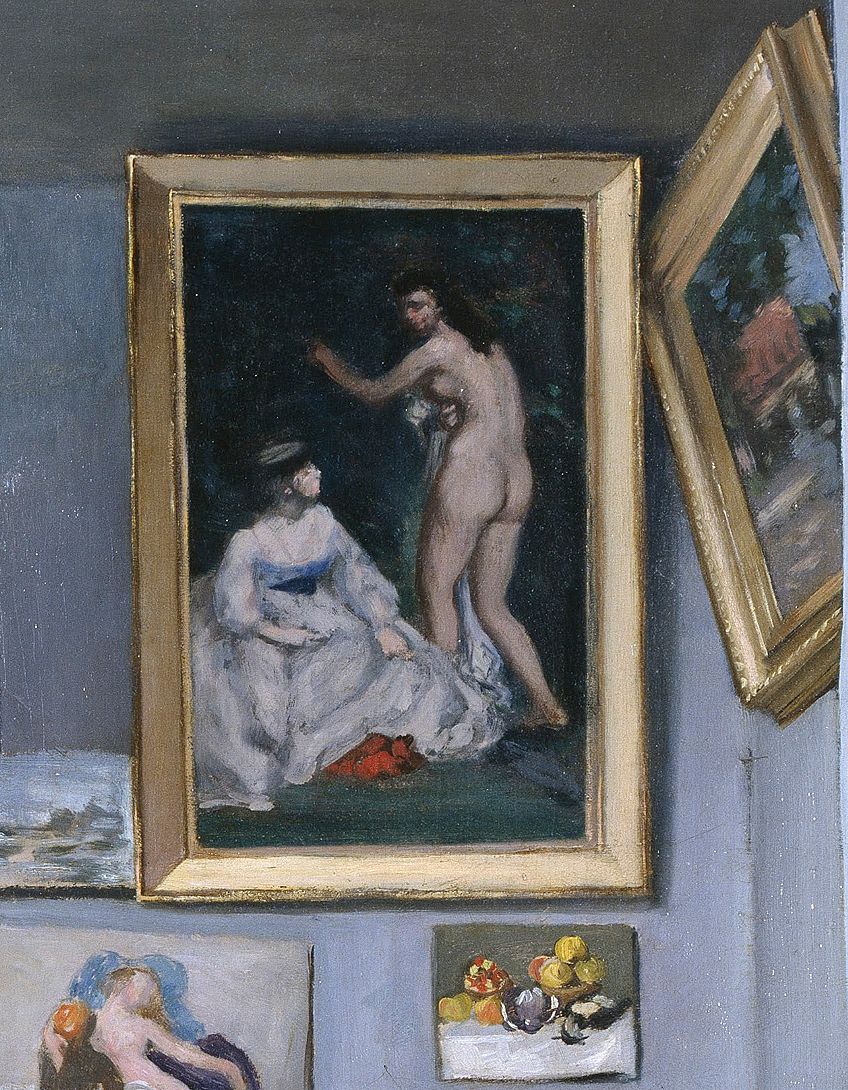
The juxtaposition in color created between the pink sofa, the red wood of the chair, and the light color of the frames all help to brighten up the grey tones present in this large room, which is further lightened by the tall window in the background.
The layout of Bazille’s Studio creates a very informal atmosphere, as the large stretch of open floor effectively divides viewers from the group of men that are convened at the far end of the studio. In doing so, Bazille gives viewers a glance into the exciting world of these revolutionary artists but manages to keep the audience separate. This implies that while viewers have technically been allowed into the studio, they will always remain on the outside looking in.
Impression, Sunrise – Claude Monet (1872)
| Artist | Claude Monet (1840 – 1926) |
| Date Painted | 1872 |
| Medium | Oil on canvas |
| Dimensions | 48 cm x 63 cm (18.9 in x 24.8 in) |
| Where It Is Currently Housed | Musée Marmottan Monet, Paris |
Considered to be the painting that gave the Impressionist movement its name, and thus seen as the most important painting of the entire period, is Claude Monet’s Impression, Sunrise, painted in 1872. Despite there being other artists already working in the Impressionist style at this point, Monet’s painting was said to truly give birth to the movement and help propel it along.
In labeling this painting an “impression” rather than a finished sketch, art critic Louis Leroy used this derogatory comment to mock the work produced by Monet and others after reviewing the First Impressionist Exhibition that took place in 1874. However, the term quickly gave rise to the emergence of the Impressionist movement, with this new group of painters deciding to fight back against the criticism they received and went on to adopt this insulting term with pride and rebellion.
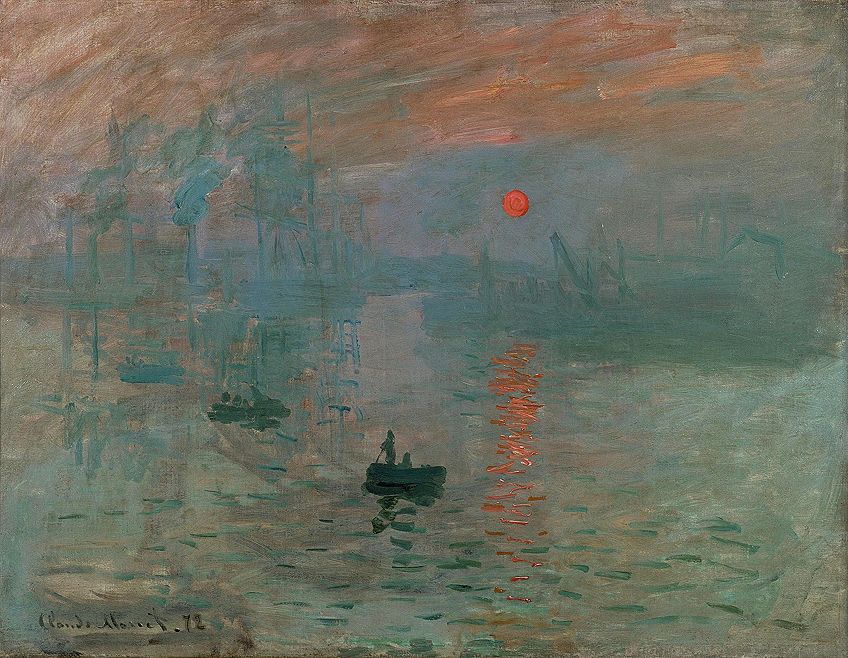
Painted after a visit to Le Havre, Monet created a striking yet harmonious balance between the colors used to depict the sea, land, and sky. With soft oranges, blues, and greens being used as the main colors to portray the sunrise, the entire composition appears to be bathed in a pastel light, which adds to the fogginess associated with the early-morning sunrise.
Whilst the title focuses on the sunrise, viewers eventually realize that the emphasis is placed on the surrounding warmth and color of sunlight as opposed to the action taking place in the port.
Utilizing abrupt, loose brushstrokes and unmixed colors, Monet managed to emphasize the thick fog and its reflection on the water. Rather than defining the work, these loose brushstrokes offer a mere suggestion of what Monet saw when painting this artwork. In the middle of the painting, viewers’ eyes are drawn to the two small rowboats in front of the red sun making its way up into the sky. Further structure is given to this Impression artwork through the chimneys and the masts of ships that can be seen in the background.
A sense of solitude is made apparent in this painting, as Monet managed to capture a moment of complete stillness and calmness before the sun rises to begin another day. Suspected to have been completed in a single sitting, so as to quickly capture the changing qualities of the light, Monet was believed to be influenced by the penetrating fog seen in the recent artworks of J.M.W Turner.
Within this painting, Monet creates a simple “impression” of his surroundings at a certain moment in time, with his depiction of ephemeral light demonstrated through the various colors used to accurately capture it as he saw it.
Thus, this painting was considered to be the trademark of the new Impressionist style, as Monet’s interest in the time-specific effects that light had on outdoor compositions is clearly represented in this misty and indistinct composition.
Existing as one of the most sought-after and celebrated Impressionist paintings to ever exist, Impression, Sunrise accurately represented the new direction that artists were headed in at the time. As it gave a name to the movement, Monet’s painting is now considered to be the quintessential symbol of Impressionism, as it perfectly typified the new artistic style that was emerging.
The Dance Class – Edgar Degas (1874)
| Artist | Edgar Degas (1834 – 1917) |
| Date Painted | 1874 |
| Medium | Oil on canvas |
| Dimensions | 83.5 cm x 77.2 cm (32.9 in x 30.4 in) |
| Where It Is Currently Housed | Metropolitan Museum of Art, New York |
Another significant French artist that helped propel the Impressionist movement forward was Edgar Degas. His 1874 artwork, titled The Dance Class, demonstrated his fascination with dance and movement, and exists as the most complex paintings he completed within his other dance-themed works. Thought to be his most ambitious painting, The Dance Class explores the idea of elegance and delicacy that was associated with ballet.
This artwork is considered to be so intricate as Degas included more than twenty figures into this composition, which allowed for many different areas to attract the attention of viewers.
However, it has been established that the dance conductor, pictured in the far right, is seen as the main focus of the painting, as he manages to stand out by being placed just outside of the main action taking place. The conductor was the renowned ballet master Jules Perrot, with Degas creating this composition based on a scene in a rehearsal room in the Paris Opera.

Seen as a classic Impressionist art piece, The Dance Class was an important artwork that was not painted outdoors, as Degas refused to adopt the en plein air technique like other Impressionists of the time. Due to this, depicting ballet practices proved to be ideal for him, as it allowed him to paint from the comfort of the opera house. Additionally, the subject matter that Degas chose to depict was motivated by financial need, as paintings of ballet dancers sold well at the time and he needed the money to help run his family business.
Rejecting the idea of being called an “Impressionist”, Degas painted The Dance Class with as much realism as he could. Despite providing a true-to-life interpretation of what he saw, this painting is still considered to be a notable artwork as it appeared to tick all of the boxes that identified artworks as Impressionistic at the time. The composition portrayed a modern scene that made use of bright colors, which added to the sense of movement that Degas attempted to capture.
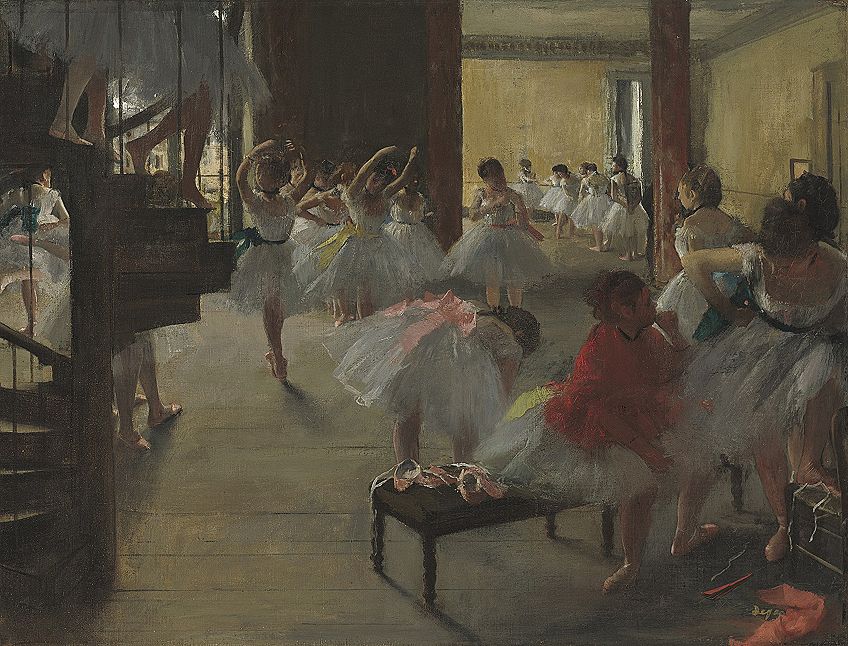
Nevertheless, the dancers appear to be devoid of any feeling and personality, which was a distinctive feature within the majority of Degas’ paintings. This was thought to be because the individuals within this painting were not the children of the wealthy French elite, rather they were the offspring of the poor and lower-class who were trying to earn a living as ballet dancers. These dancers were required to train for long hours under the harsh guidance of their dance master, which created an entirely different perception of ballet.
The Dance Class was commissioned by the singer Jean-Baptiste Faure, which required Degas to prepare countless study pieces of dancers before completing the final artwork. As he was initially trained in the techniques of academic art, Degas brought a refined understanding of the human body to this painting. This was demonstrated through the way he was able to capture the elegance of the ballerinas in such a beautiful and accurate way.
Seen as his most famous piece, this painting by Degas is integral in understanding the Impressionist movement.
Fog, Voisins – Alfred Sisley (1874)
| Artist | Alfred Sisley (1839 – 1899) |
| Date Painted | 1874 |
| Medium | Oil on canvas |
| Dimensions | 650 cm x 500 cm |
| Where It Is Currently Housed | Musée d’Orsay, Paris |
French artist Alfred Sisley was another important contributor to the Impressionist movement and produced some notable artworks during his career. One of his well-known Impressionism artworks was said to be Fog, Voisins, which he painted in 1874. As an artist, Sisley fully committed to the Impressionist technique and consistently painted en plein air, which can be seen in the many landscape compositions he created.
After settling in a village in Voisins, Sisley went on to paint this beautiful pastoral scene which depicted a heavy fog that had set in. A few structures can be seen through the mist, such as the outline of the fence and the twisted branches of a tree in the background of the painting. Despite appearing hazy, the central subject matter is said to be the crouched woman tending to her garden or picking flowers.
The bluish-grey tone used to depict the woman helps set her aside from the rest of the scene, as she appears darker than the mist Sisley was trying to capture.
Additionally, the combination of these colors creates a silvery glow around her, which adds to the slightly mysterious atmosphere that is created through the woman’s isolation. The gentle color palette used by Sisley conveys a scene that is both expressive yet completely tranquil at the same time, which emphasizes the relaxing quality of the landscape.

Through creating a composition almost completely devoid of other human figures, Sisley was able to highlight the overwhelming peace that can be found in outdoor spaces where humans do not interfere. Despite including the lone woman tending to her garden, the fog that Sisley painted almost entirely obscures her and the meadow, which adds to the anonymity felt. Her body seems to effortlessly blend into the outside world around her, which was said to represent a comment made by Sisley about the wider natural world.
As the predominant color used is grey, Sisley managed to create a very shadowy scene, where the lone woman appears to be emerging from the fog like some sort of spectral figure. Despite Sisley depicting a landscape in his Fog, Voisins, it would have been highly unlikely that he was able to capture the entire scene in one sitting. Due to the fast-changing qualities of the mist, Sisley would have had to construct this painting from some preliminary sketches that he would have taken over a period of time. Due to this, Fog, Voisins is not made up of the short and loose brushstrokes that characterized other Impressionist paintings at the time.
However, this painting is still unmistakably Impressionist in nature, as Sisley experimented with the transient quality of light and shade through the colors he chose.
The Cradle – Berthe Morisot (1872)
| Artist | Berthe Morisot (1841 – 1895) |
| Date Painted | 1872 |
| Medium | Oil on canvas |
| Dimensions | 56 cm x 46 cm |
| Where It Is Currently Housed | Musée d’Orsay, Paris |
An important female artist within the Impressionist movement was Berthe Morisot, who produced some incredibly notable works during the period. Her 1872 painting, titled The Cradle exists as the most well-known work of hers due to the Impressionistic techniques she displayed.
Within this painting, Morisot depicted her sister, Edma, looking down at her infant daughter asleep in a cradle that is partially hidden by a transparent veil. As one of the earlier works in her career, Morisot managed to capture the complicated theme of motherhood from a mature perspective, which can be felt when looking at this painting.
Motherhood would go on to become a recurring subject in her many paintings, as Morisot deeply explored the issues related to women’s social limitations during that time period.
Despite being generally admired by critics when it was first exhibited in 1874, The Cradle was not sold. The techniques used by Morisot to paint her sister, combined with the contentious subject matter exploring the social standing of women, made this artwork an incredibly controversial painting at the time.

Morisot creates a balanced composition through the position of Edma’s body in relation to the veil, which went on to imply the subconscious harmony that was said to be present between a parent and child. Through painting a translucent veil over the child, Morisot manages to protect her identity from viewers whilst still emphasizing the private relationship a mother has with her child.
Movement is also seen within this painting through the diagonal line created between Edma’s bent arm and the line of the curtain, which was an aspect that many Impressionists experimented with. This diagonal line further emphasizes the connection felt between Edma and her baby, as Morisot creates a very intimate scene that viewers have been allowed to glance in on.
In essence, The Cradle depicts a scene filled with intimacy and protection, with Morisot implying that a mother’s love can shield others from harm.
As not much detail is given to the facial features of Edma, viewers remain unsure as to her thoughts and feelings. This was said to be a typical trait of Morisot within her paintings, as it represented the mystery associated with women who had to constantly hide aspects of themselves during this time. Additionally, The Cradle did not receive much interest at the Impressionist exhibition in 1874 due to its subject matter, which forced Morisot to withdraw it from being viewed.
Dance at Le Moulin de la Galette – Pierre-Auguste Renoir (1876)
| Artist | Pierre-Auguste Renoir (1841 – 1919) |
| Date Painted | 1876 |
| Medium | Oil on canvas |
| Dimensions | 131 cm x 175 cm (52 in x 69 in) |
| Where It Is Currently Housed | Musée d’Orsay, Paris |
French artist Pierre-Auguste Renoir was another notable figure within Impressionism, who went on to create countless iconic paintings during the movement. One of his well-known paintings, which he created in 1876, is his Dance at Le Moulin de la Galette, which was one of the first paintings that Renoir ever exhibited in 1877.
Seen to portray the typical Parisian life, this painting exists as a prime example of the Impressionist style. Described to be the “most beautiful painting of the 19th century”, Renoir’s artwork depicted a snippet of ordinary life in the trendy French neighborhood of Montmartre. During this time, the courtyard of the Moulin de la Galette, which is still operational today, was a meeting spot for the working class to go drink, eat, and dance after a long day of work.
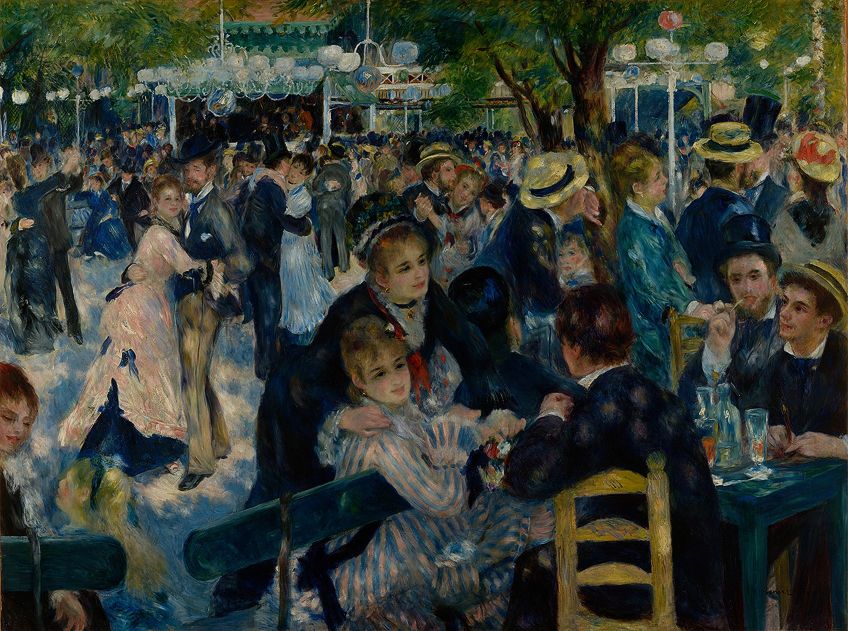
While many of Renoir’s friends and other notable artists were said to be present within the painting, the focus on the artwork falls on the cheerful atmosphere felt in this garden in Montmartre. Despite the sheer quantity of people in this painting, Renoir was still able to capture a great amount of detail in this incredibly busy scene.
A variety of viewpoints and angles are provided for viewers to consider, which demonstrated that many possible focal elements exist within this painting.
The biggest element that Renoir explored within Dance at Le Moulin de la Galette was the element of sunlight, as his entire composition appears to be bathed in the natural light streaming in from above the trees. As the sunlight appears to be flickering, movement is also represented within this artwork which went on to further emphasize the hustle and bustle present in this courtyard. Using a larger-than-normal canvas for his painting, Renoir gave himself enough space to fully explore the activity he felt when looking at this scene.

Other elements of Impressionism are seen through the colorful brushstrokes Renoir used to depict the happiness he saw. Additionally, these contrasting shades of color go on to emphasize the distinction between light and shade seen from the canopy of trees above the figures. Through this depiction of light, Renoir offers viewers an almost blurry representation of the crowd, as the focus of the artworks falls on the celebration that is taking place as opposed to who these people are.
Although this artwork is celebrated today, it was initially met with negative criticism from art critics and audiences at the time. Within this painting, Renoir was able to demonstrate his true talent for painting, as he effortlessly combined elements of portraiture, still life, and landscape works into Dance at Le Moulin de la Galette.
Due to the sheer size of the artwork, this Impression artwork proved to be an ambitious challenge at the time, as no artist before Renoir had attempted a painting of this magnitude.
Paris Street, Rainy Day – Gustave Caillebotte (1877)
| Artist | Gustave Caillebotte (1848 – 1894) |
| Date Painted | 1877 |
| Medium | Oil on canvas |
| Dimensions | 212.2 cm x 276.2 cm (83.5 in x 108.7 in) |
| Where It Is Currently Housed | Art Institute of Chicago |
Another important influence within the Impressionism movement was French artist Gustave Caillebotte. Despite painting more realistically, Caillebotte is still considered to have provided iconic Impressionist paintings during the period’s peak. His 1877 painting, titled Paris Street, Rainy Day, is one of his most well-known artworks.
Seen as a rather unusual painting as it depicted a rainy day without showing any actual rain, Caillebotte’s painting went on to achieve great success. Despite the inclusion of umbrellas and shiny cobblestones, which appear to be wet when first looking at the painting, these elements simply imply the possibility of rain without any being seen by viewers. Caillebotte’s masterful manipulation of light and shadows helps to create the impression of water on the street, making it easier for viewers to relate to the title of the work.
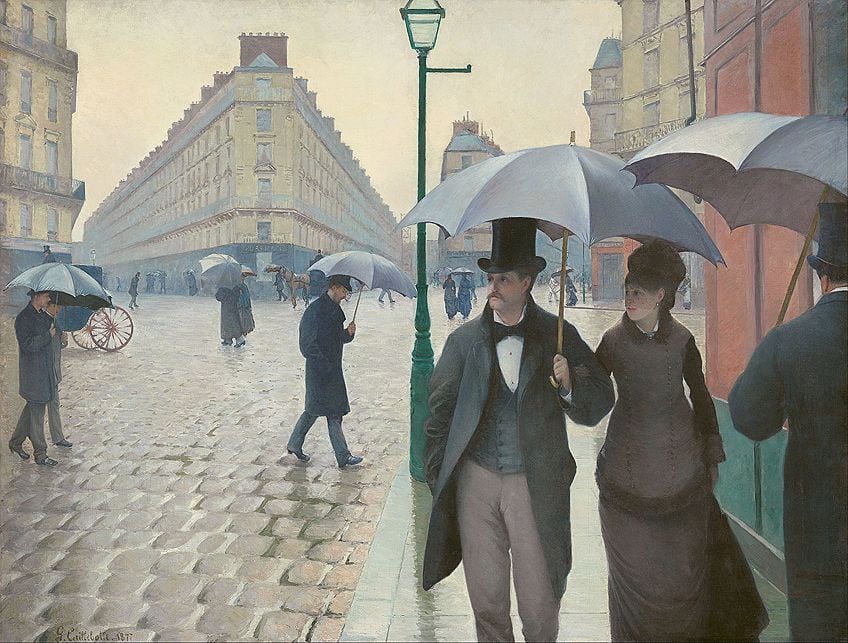
Paris Street, Rainy Day portrays a number of people passing each other with an air of detachment in an area thought to be Place de Dublin, which is the 8th arrondissement of Paris. It is considered to be a great picture capturing urban life in the 19th century, as the precision demonstrated by Caillebotte within this painting gives the work an almost photographic appearance. This is essentially one of the main reasons that the artwork was thought to be more Realistic than Impressionistic in terms of its characteristics.
Caillebotte incorporated elements associated with photography within this painting, such as depicting figures that appear to be “out of focus”. This led to wide criticism, as such a modern portrayal of man within a seemingly isolated composition was completely unfamiliar at the time.
The preciseness that Caillebotte painted this artwork with demonstrates his dependence on realism and line, rather than the loose and broad brushstrokes of typical Impressionism artworks.
Thus, upon closer inspection, it becomes quite clear that Caillebotte had a keen interest in photography, as many elements within Paris Street, Rainy Day seem to have sharp edges that were thought to be influenced by photographs. The photorealism is particularly evident within this painting, with Caillebotte going further to distort the balance within his artwork. This was done by cropping the man in the far right of the painting, as well as depicting the couple in the foreground in a much more prominent light than the other figures.

Often painting individuals belonging to the working class, Caillebotte provided accurate depictions of the isolation man felt in modern cities at the time. Through depicting ordinary people out for a casual walk, Caillebotte was able to transfer the emphasis of the painting onto the alienation of individuals within the newly refurbished Parisian capital. Additionally, no identity is given to any of the figures, which adds to the total anonymity felt within this painting and the city alike.
The focus of the painting eventually falls on the indifferent gaze of the man holding the umbrella in the foreground, who seems to be unbothered with the atmosphere around him. The inclusion of this figure was said to represent the ever-changing French society at the time, which made Paris Street, Rainy Day one of the best depictions of 19th century Paris.
In the Loge – Mary Cassatt (1878)
| Artist | Mary Cassatt (1844 – 1926) |
| Date Painted | 1878 |
| Medium | Oil on canvas |
| Dimensions | 81 cm x 66 cm (32 in x 26 in) |
| Where It Is Currently Housed | Museum of Fine Arts, Boston |
As the only American artist to exhibit with the Impressionist group, Mary Cassatt was a valuable addition to the movement. Her 1878 painting, titled In the Loge, is a well-known Impression artwork of hers, done with oil paints instead of pastels, which she often preferred to make use of in her works.
This oil painting proved to be a significant Impressionist piece, as Cassatt demonstrated a variety of techniques associated with the movement in this painting.
Within In the Loge, Cassatt depicted a popular past-time of wealthier individuals in 19th century Paris, as going to the opera was seen as a common occurrence then. The opera was a place to see and be seen, which meant that individuals often dressed up extravagantly. Women, in particular, would wear lots of jewelry and only show an appropriate amount of skin when out in public, while men would be dressed in black suits so as to disappear seamlessly into their opera boxes without being seen.
In this composition, Cassatt depicts an elegantly dressed woman attending a daytime performance at the Comedie-Francaise, which was an iconic theatre in Paris at the time. Viewers are only able to see the woman’s profile, as she appears to be fully engrossed in the action that is taking place on stage. Giving the figure a more active role, Cassatt portrayed the woman to be looking through opera glasses at something that cannot be seen by audiences, while a man in the background seems to have his attention trained specifically on her.

As both the woman and the man in the upper left corner stick out for viewers, a chain of attention is created. Audiences are given two focal points to concentrate on yet despite this, the emphasis of the painting repeatedly falls on the anonymous woman. Thus, In the Loge explores the mere act of watching, as Cassatt breaks down the boundaries that exist between onlookers and observed, as well as spectators and performers.
Through painting the figure with a black dress, Cassatt refuses to offer up her body as a spectacle to be gazed at, which allows her to blend into her environment. The defensive manner in which she holds her fan suggests to viewers that she simply wants to watch the opera in peace, creating an air of rigidity within this work. However, the view from an opera box was often not a very good one, which explains the use of the glasses.
This also represents the comment that Cassatt was attempting to make about upper-class society at the time, as access to certain spaces was banned to women. This was why the Opera proved to be such a recurring subject matter for female artists, as they were reluctantly granted access to this space as opposed to other public areas.
In the Loge thus proved to be an important contribution to the Impressionist movement, as Cassatt went on to become one of only three women, as well as the only American, to ever join the Impressionist group.
Afternoon Tea – Marie Bracquemond (1880)
| Artist | Marie Bracquemond (1840 – 1916) |
| Date Painted | 1880 |
| Medium | Oil on canvas |
| Dimensions | 81.5 cm x 61.5 cm |
| Where It Is Currently Housed | Musée des Beaux-Arts de la Ville de Paris |
Another significant female artist within the Impressionist movement was Marie Bracquemond, who often flew under the radar in comparison to her contemporaries. While her paintings may not as well-known as others, some of her works stand out. An important painting of hers, done in 1880, is Afternoon Tea.
Within this painting, Bracquemond depicted her sister, Louise, who was shown to be reading a book in the garden. Painting in a very whimsical way, Bracquemond made use of muted and pastel colors in Afternoon Tea so as to create a very calming and relaxed atmosphere. Including white as her main color, Louise is painted in a very demure way, which is further emphasized by her gaze which is directed away from viewers. When looking at her facial expression, audiences are left with the feeling that Louise is unsatisfied with something.
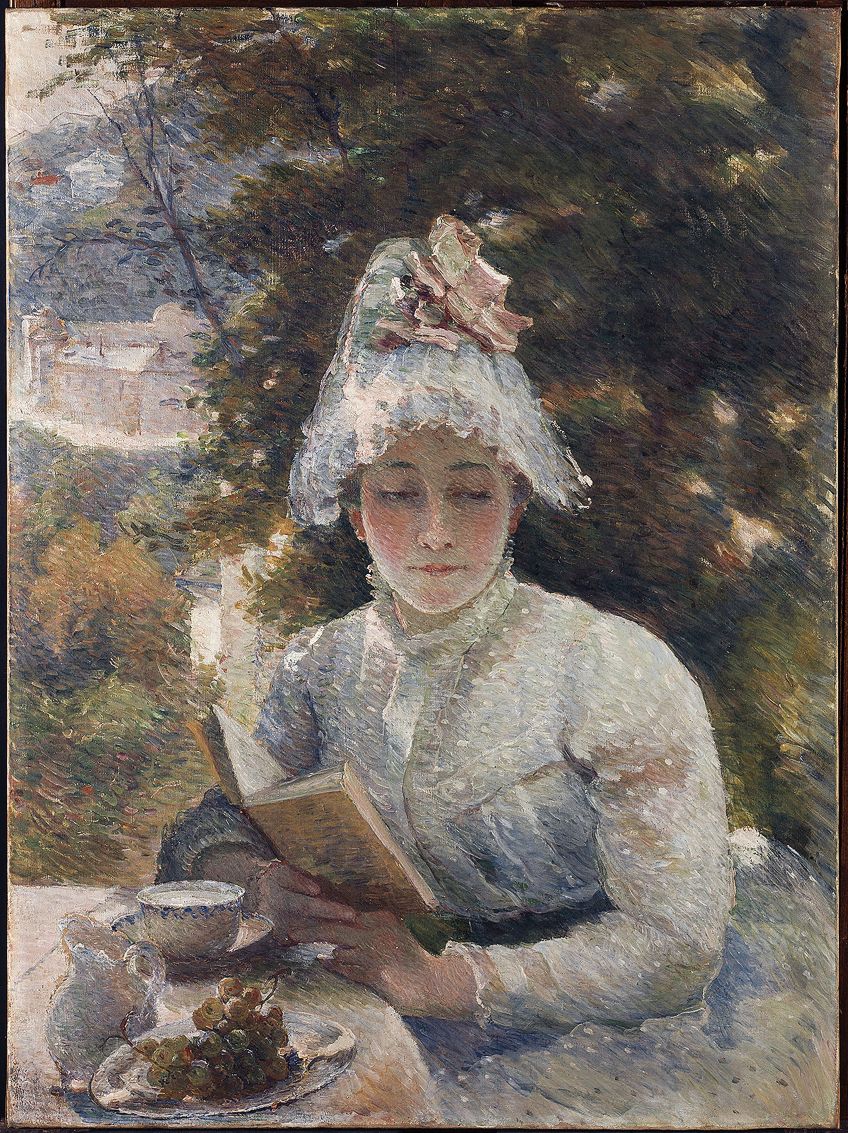
By including a book, Bracquemond provides her sister with something to do within the composition, yet she seems to be fascinated by something else entirely. Despite her eyes being turned away from the book in her hands, critics have stated that she appears to be completely absorbed in what she is reading, which could account for her lack of focus.
Afternoon Tea exists as a good example of an Impressionist art piece, as Bracquemond made use of many characteristics associated with the movement. Loose brushstrokes can be seen, along with a light-infused color palette that has been experimented with to create an atmosphere of airiness in this painting.
By depicting her sister onto a surface bathed in light, Bracquemond began to carve out the style for which she was known.
Luncheon of the Boating Party – Pierre-Auguste Renoir (1881)
| Artist | Pierre-Auguste Renoir (1841 – 1919) |
| Date Painted | 1881 |
| Medium | Oil on canvas |
| Dimensions | 129.9 cm x 172.7cm (51in x 68 in) |
| Where It Is Currently Housed | The Phillips Collection, Washington D.C. |
Another iconic painting by Pierre-Auguste Renoir is his 1881 artwork, titled Luncheon of the Boating Party. Featured in the seventh Impressionist exhibition, this painting received some tongue-in-cheek compliments from a number of otherwise incredibly aggressive critics, denoting its importance within the movement.
Seen as a classic Renoir painting, the subject matter is contemporary in nature. By depicting a lunch scene of a restaurant overlooking the Seine river, where individuals are shown to be talking, laughing, and sharing food and wine, Renoir managed to capture an atmosphere of complete jubilation taking place on a Sunday afternoon. Renoir was said to include both himself and some of his friends within this composition, as he wanted to emphasize the importance of relaxing and having fun with others on the weekend.
He stressed that no underlying moral message accompanied this painting, as the ability to let go and unwind was as important a message as any other.
As viewers were not required to look for a specific message in order to fully understand the painting, more focus was placed on the themes that Renoir combined when creating this artwork. Through blending elements of portraiture, still lifes, and landscapes within Luncheon of the Boating Party, Renoir created an impressive painting that incorporated a variety of genres.

However, the most important characteristic present within this work was that it appeared to be painted en plein air, which was a feature of most Impressionist paintings at the time. Additionally, an exquisite color palette was used, along with Renoir’s fluid brushstrokes and gentle manipulation of light. Despite the chaotic subject matter, light appears to be the central feature within this painting.
By portraying dappled and soft beams of light coming in through the trees and canopy, Renoir creates an incredibly relaxed and gentle atmosphere.
The handrail seen in the upper left corner functions as an endpoint within the composition, which creates a break from the chaotic action felt through the inclusion of so many figures. However, a very happy and merry attitude is implied by all of these individuals, who appear to be thoroughly enjoying their Sunday afternoon along the river.
Celebrated for its delightfulness, Luncheon of the Boating Party represented the changing society within France during the late 19th century due to the consequences of the Industrial Revolution. At this point, restaurants were suddenly very welcoming of individuals from many different social classes, with Renoir’s typical glossy style capturing the pleasure and delight felt during this changing time.
A Bar at the Folies-Bergère – Édouard Manet (1882)
| Artist | Édouard Manet (1832 – 1883) |
| Date Painted | 1882 |
| Medium | Oil on canvas |
| Dimensions | 96 cm x 130 cm (37.8 in x 51.2 in) |
| Where It Is Currently Housed | Courtauld Gallery, London |
Another significant work painted by Édouard Manet was A Bar at the Folies-Bergère, which he created in 1882. Despite showing reluctance at being labeled an “Impressionist”, this artwork exists as one of his most iconic Impressionist paintings created, which firmly cemented him in the movement. This was also the last major artwork produced by Manet, which added to its status.
Noted for its intricate detail, A Bar at the Folies-Bergère depicted an ordinary barmaid working in the Folies-Bergère nightclub. Despite the subject matter appearing to be simple, Manet filled this canvas with many details to look at and consider, which made it a very busy composition to view. The focus of the artwork falls on the woman in the center, who has a very distant and detached expression on her face.

Thought to be serving a customer based on the way her body is turned towards the counter, the barmaid appears to be listening attentively as to what is going on around her. However, her facial expression gives her away, as her pensive look does not match her body language. Within this painting, Manet demonstrates two sides of a woman’s experience in this era. In the mirror reflection in the top right corner, she is shown to be meticulously serving a customer, while viewers are greeted with her honest expression of how she truly feels.
The rich details that Manet provides help viewers piece together the overall atmosphere felt within this painting, with these details existing as clues as to the social class and ambiance of the time.
Despite all of the distracting objects seen around the barmaid, which give off the impression of a jovial time, a scene filled with hollowness and apathy becomes clear. At the time, Manet associated prostitution with the inclusion of oranges in his paintings. Thus, based on the dish of oranges next to the barmaid, it was implied that she was also a prostitute.
The duality of the barmaid’s role becomes clearer through the oranges, as it is suggested that she also exists as something that can be purchased, much like the drinks she is selling. Based on this assumption, in addition to the fact that his last major work depicted a scene within a nightclub, A Bar at the Folies-Bergère has been the subject of much debate throughout art history.
Boulevard Montmartre – Camille Pissarro (1897)
| Artist | Camille Pissarro (1830 – 1903) |
| Date Painted | 1897 |
| Medium | Oil on canvas |
| Dimensions | 53 cm x 65 cm |
| Where It Is Currently Housed | National Gallery, London |
French artist Camille Pissarro was another important Impressionist, who created many well-known Impressionism paintings. Some of his more notable paintings come from a series of works that focused on the district of Montmartre in Paris. His 1897 painting, titled Boulevard Montmartre is one of his notable works from that area.
During February and April of 1897, Pissarro occupied a room at the Hotel de Russie in Paris and created a series of over 14 paintings that focused specifically on the Boulevard Montmartre at different times of the day and year. Pissarro captured the boulevard between the winter and spring seasons, as well as during the sun, rain, fog, mist, and sunset. This left him with an extensive collection of paintings that focused on the same subject matter, which allowed Pissarro to truly appreciate the scene he was depicting over and over again.

This excellent urban scene that Pissarro created of Paris within Boulevard Montmartre shows off the action and commotion that frequently took place along the road, as a very busy composition is created. As Pissarro painted in a distinctly Impressionistic style and gave little defining details to the figures and apartment blocks that lined the boulevard, viewers still get the impression that they are familiar with this scene when looking at it. The color palette that Pissarro chose was also muted, as he focused on browns, dark oranges, blues, and blacks.
As he was suffering from failing eyesight towards the end of his life, Pissarro painted Boulevard Montmartre from inside a hotel room, despite the painting depicting an outdoor scene. Pissarro placed his focus on the interplay of light found within this painting as opposed to the structure of the street and buildings, which was why he created so many versions of the same painting.
His series proved to be greatly popular, with one of the Boulevard Montmartre artworks selling for £19.1 million in 2014.
The Water-Lily Pond – Claude Monet (1899)
| Artist | Claude Monet (1840 – 1926) |
| Date Painted | 1899 |
| Medium | Oil on canvas |
| Dimensions | 88.3 cm x 93.1 cm |
| Where It Is Currently Housed | The National Gallery, London |
The final artwork that is included in our list of top 15 Impressionist paintings is The Water-Lily Pond, painted by Claude Monet in 1899. Best known for his numerous depictions of water lilies, Monet produced over 250 paintings within a series focusing on them. The Water-Lily Pond is one of the significant paintings to come from that series. The water-lily pond, complete with the Japanese bridge, was designed by Monet himself, although he only managed to capture it in about three paintings.
After moving to Giverny, a small town outside of Paris, Monet began renovations on a large farmhouse and its accompanying garden. He then went on to create an intricate water garden, which became the inspiration behind The Water-Lily Pond and the other paintings within his iconic series.
This composition was considered to be remarkable on so many levels, as no artist before Monet had used color, light, and reflection in such a skillful way.
The most striking element of The Water-Lily Pond is the quiet reflection that Monet managed to create within this painting. With an impression of dappled sunlight that Monet created through the shadows in and amongst the trees, light proved to be an important feature in this depiction of his garden. The combination of color, tone, and texture was done in such a way that a truly peaceful and gentle atmosphere is conveyed to viewers, as Monet’s garden becomes a serene and almost-heavenly location.

The depiction of light through the short and rapid brushstrokes used exemplified Monet’s approach to en plein air paintings. Monet was said to visit his garden up to three times a day so as to study and accurately capture the changing light, which led to him creating so many compositions of the same subject matter. However, the focal point within this painting exists as the subtle lilies shown to be floating in the pond, as they are identified through the faint dabs of paint that Monet added to the water.
Within The Water-Lily Pond, as well as the other depictions of water lilies that Monet painted while in Giverny, an incredible sense of harmony and balance is felt when looking at his works. Admitting that he was obsessed with his water garden, Monet continued to depict water lilies until his death. With his water lilies series being labeled as “the Sistine Chapel of Impressionism”, it existed as the most comprehensive series of paintings produced by him.
The Impressionism movement proved to be an incredibly influential movement within art history. While only 15 famous Impressionist paintings have been explored above, many more iconic paintings can still be added to the list. Most of the well-known artists went on to produce a variety of Impressionism artworks that are considered to be vital in the movement’s development. If you have enjoyed this article, we encourage you to further explore other Impressionism paintings.
Take a look at our famous Impressionist paintings webstory here!
Isabella studied at the University of Cape Town in South Africa and graduated with a Bachelor of Arts majoring in English Literature & Language and Psychology. Throughout her undergraduate years, she took Art History as an additional subject and absolutely loved it. Building on from her art history knowledge that began in high school, art has always been a particular area of fascination for her. From learning about artworks previously unknown to her, or sharpening her existing understanding of specific works, the ability to continue learning within this interesting sphere excites her greatly.
Her focal points of interest in art history encompass profiling specific artists and art movements, as it is these areas where she is able to really dig deep into the rich narrative of the art world. Additionally, she particularly enjoys exploring the different artistic styles of the 20th century, as well as the important impact that female artists have had on the development of art history.
Learn more about Isabella Meyer and the Art in Context Team.
Cite this Article
Isabella, Meyer, “Impressionist Paintings – A Look at the Best Impressionism Artworks.” Art in Context. June 28, 2021. URL: https://artincontext.org/impressionist-paintings/
Meyer, I. (2021, 28 June). Impressionist Paintings – A Look at the Best Impressionism Artworks. Art in Context. https://artincontext.org/impressionist-paintings/
Meyer, Isabella. “Impressionist Paintings – A Look at the Best Impressionism Artworks.” Art in Context, June 28, 2021. https://artincontext.org/impressionist-paintings/.


